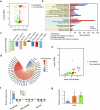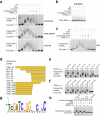A RsrC-RsrA-RsrB transcriptional circuit positively regulates polysaccharide-degrading enzyme biosynthesis and development in Penicillium oxalicum
- PMID: 38992164
- PMCID: PMC11239660
- DOI: 10.1038/s42003-024-06536-4
A RsrC-RsrA-RsrB transcriptional circuit positively regulates polysaccharide-degrading enzyme biosynthesis and development in Penicillium oxalicum
Abstract
Filamentous fungi produce polysaccharide-degrading enzymes, which is controlled by poorly understood transcriptional circuits. Here we show that a circuit comprising RsrC-RsrA-RsrB (Rsr: production of raw-starch-degrading enzyme regulator) that positively regulates production of raw starch-degrading enzymes in Penicillium oxalicum. Transcription factor (TF) RsrA is essential for biosynthesis of raw starch-degrading enzymes. RsrB and RsrC containing Zn2Cys6- and C2H2-zinc finger domains, act downstream and upstream of RsrA, respectively. RsrA activates rsrB transcription, and three nucleotides (G-286, G-287 and G-292) of rsrB promoter region are required for RsrA, in terms of TF, for binding. RsrB165-271 binds to DNA sequence 5'-TCGATCAGGCACGCC-3' in the promoter region of the gene encoding key raw-starch-degrading enzyme PoxGA15A. RsrC specifically binds rsrA promoter, but not amylase genes, to positively regulate the expression of rsrA and the production of raw starch-degrading enzymes. These findings expand complex regulatory network of fungal raw starch-degrading enzyme biosynthesis.
© 2024. The Author(s).
Conflict of interest statement
The authors declare no competing interests.
Figures










Similar articles
-
Mutual regulation of novel transcription factors RsrD and RsrE positively modulates the production of raw-starch-degrading enzyme in Penicillium oxalicum.Appl Environ Microbiol. 2024 Aug 21;90(8):e0039024. doi: 10.1128/aem.00390-24. Epub 2024 Jul 18. Appl Environ Microbiol. 2024. PMID: 39023351 Free PMC article.
-
Transcription Factor NsdD Regulates the Expression of Genes Involved in Plant Biomass-Degrading Enzymes, Conidiation, and Pigment Biosynthesis in Penicillium oxalicum.Appl Environ Microbiol. 2018 Aug 31;84(18):e01039-18. doi: 10.1128/AEM.01039-18. Print 2018 Sep 15. Appl Environ Microbiol. 2018. PMID: 29980558 Free PMC article.
-
Secretory overproduction of a raw starch-degrading glucoamylase in Penicillium oxalicum using strong promoter and signal peptide.Appl Microbiol Biotechnol. 2018 Nov;102(21):9291-9301. doi: 10.1007/s00253-018-9307-8. Epub 2018 Aug 28. Appl Microbiol Biotechnol. 2018. PMID: 30155751
-
Every road leads to Rome: diverse biosynthetic regulation of plant cell wall-degrading enzymes in filamentous fungi Penicillium oxalicum and Trichoderma reesei.Crit Rev Biotechnol. 2024 Nov;44(7):1241-1261. doi: 10.1080/07388551.2023.2280810. Epub 2023 Nov 30. Crit Rev Biotechnol. 2024. PMID: 38035670 Review.
-
Recent advances in genetic engineering to enhance plant-polysaccharide-degrading enzyme expression in Penicillium oxalicum: A brief review.Int J Biol Macromol. 2024 Oct;278(Pt 2):134775. doi: 10.1016/j.ijbiomac.2024.134775. Epub 2024 Aug 15. Int J Biol Macromol. 2024. PMID: 39153674 Review.
References
Publication types
MeSH terms
Substances
Supplementary concepts
Grants and funding
LinkOut - more resources
Full Text Sources
Miscellaneous

